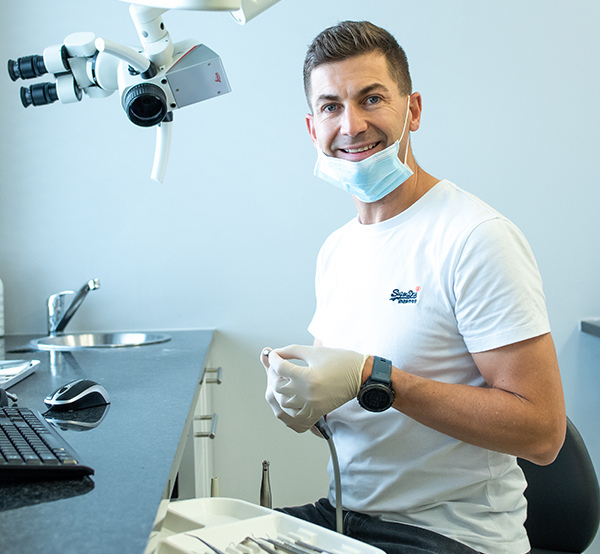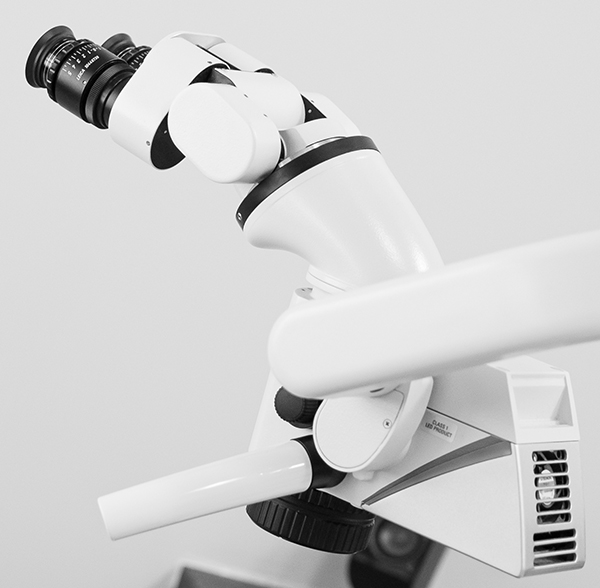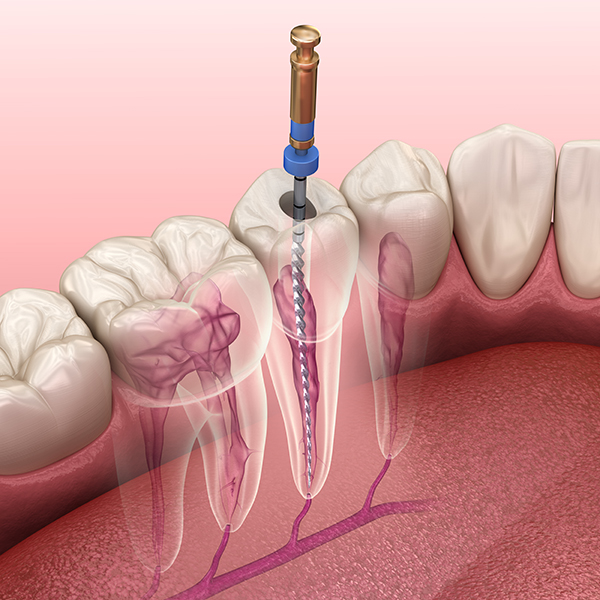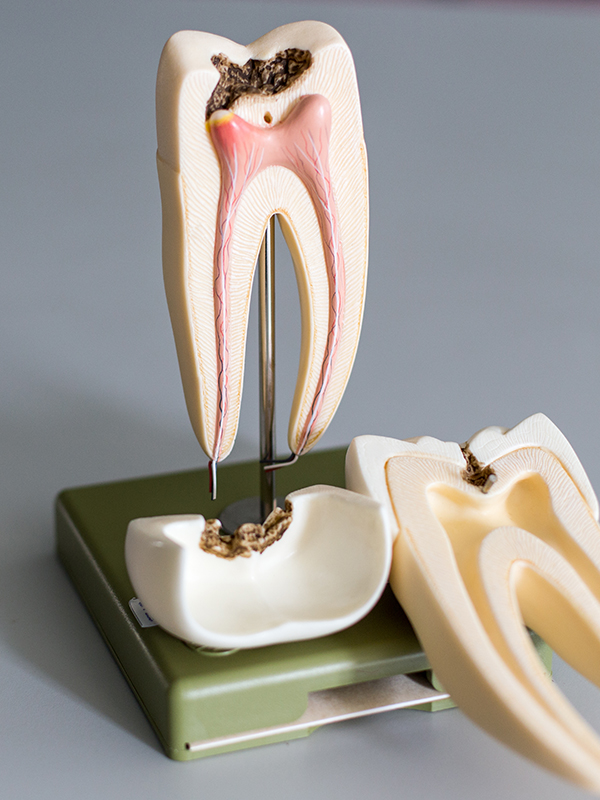Root canal therapy (Endodontics)
The only way to save a tooth when the nerve becomes infected or abscessed is with endodontic therapy. Also known as a root canal, this procedure has a reputation for being uncomfortable and complicated. There are many microscopic canals and structures that need to be expertly treated during the procedure, so it takes time and diligence to ensure it is done properly.
Thankfully, we have vast experience in dealing with complicated endodontic procedures. With our knowledge and skill, your root canal treatment will be as pain-free as possible with minimal discomfort during your recovery.

Our resident Endodontist has vast experience in dealing with complicated endodontic procedures. With our knowledge and skill, your root canal treatment will be as pain-free as possible with minimal discomfort during your recovery.
What causes root canal infection?
The tooth pulp generally becomes infected when bacteria manages to bypass the enamel and reach the pulp, where the sensitive nerve endings are stored. There are many different circumstances that could lead to the pulp becoming infected, including cracked and broken teeth and cavities. Regardless of the cause of your discomfort, our highly trained and vastly experienced endodontist can assist you in relieving your discomfort.
What is a root canal?
Each tooth has spaces in the centre which hold the pulp and nerves. At times, these spaces may become infected and inflamed, causing great pain and discomfort.
What is root canal treatment?
When the canal becomes infected and inflamed, you’ll need a specific treatment to alleviate the pain and stop the damage. During root canal treatment, our endodontist, will remove the affected pulp before cleaning and sealing the canal.

The root canal treatment process
- 1. We start off by giving patients local anaesthetic to make them feel comfortable.
- 2. Next, the infected pulp is removed from all the root canals.
- 3. We develop all canals in the tooth along their entire length enabling accurate disinfection of their interior, which determines a good treatment prognosis.
- 4. The thoroughly disinfected canal is tightly filled along the entire length up to the root tip with strong material.
- 5. The final step of treatment is tooth reconstruction. The reconstruction helps protect against its fracture and the re-entrance of bacteria into the canal.

Microscopes in root canal treatment
The components of a tooth are minuscule and often hide signs of disease or damage within. Using microscopic dentistry and dental magnification, we can identify and treat problems as they arise, long before they cause damage or pain.
We perform root canals under the enlargement of an operating microscope. The microscope allows her to find all main and additional canals in the tooth, remove the infected pulp, old cement or even broken endodontic instruments left in the canals. The end result is accurate and precise treatment with better outcomes.
Why choose our root canal treatments?
- We use a rubber dam to ensure the effectiveness and efficiency of the dentist's work.
A rubber dam is a sheet of latex rubber that is stretched on a special frame and adheres very closely to the tooth being treated. A perforated latex leaf tightly surrounds the treatment area, improving visibility and protecting it against access to bacteria and saliva.
In addition, the rubber dame shortens the time of the procedure since there's no need to constantly replace the lignin rollers. The rubber dam allows us to protect against possible irritation of soft tissues by flushing agents used in the disinfection of canals. The rubber dam also protects against accidental injury with a drill or the instruments accessing the respiratory tract.
- Work in enlargement leads to very high accuracy of treatment.
Thanks to the operating microscope, we can control every stage of root canal treatment. We are able to enlarge the treatment area up to 20X! Microscopes play a key role in learning about the anatomy of the canal, checking the quality of its development, and filling tightness. It allows us to perform very complex procedures.
- Precise and tight closing of the canals thanks to the liquid gutta-percha.
After decontaminating and developing the root canal, we proceed to fill it. For this purpose, a plant-based material called gutta-percha which has thermoplastic properties when heated. Another advantage of gutta-percha is its biocompatibility with periapical tissues, ease of entrance into the canal, as well as antibacterial properties. Gutta-percha fills the branches of the main canals and gives a contrast view on the x-ray images.
- Confidence of treatment thanks to advanced imagery
We take a series of photos to be 100% sure that the treatment is going well during the procedure and after it.
Why sometimes it is necessary to repeat the root canal treatment the so-called reendo?
One of the basic research considering our new patients is careful assessment of all root canals of treated teeth. For this purpose, we use computed tomography, i.e. three-dimensional X-ray diagnostics. We assess whether all root canals are filled to the root apex, whether they are properly developed and whether there are no inflammatory changes in the bone around such tooth. If any of these elements raises our doubts, we qualify the tooth for repeated root canal treatment. The goal of such treatment is to eliminate bacterial infection in the canals, to treat inflammatory changes around the top of the tooth and to eliminate foci of infection that are dangerous to the health of the whole body.


Is every tooth suitable for reendo?
One of the basic research considering our new patients is careful assessment of all root canals of treated teeth. For this purpose, we use computed tomography, i.e. three-dimensional X-ray diagnostics. We assess whether all root canals are filled to the root apex, whether they are properly developed and whether there are no inflammatory changes in the bone around such tooth. If any of these elements raises our doubts, we qualify the tooth for repeated root canal treatment. The goal of such treatment is to eliminate bacterial infection in the canals, to treat inflammatory changes around the top of the tooth and to eliminate foci of infection that are dangerous to the health of the whole body.
If the tooth is badly damaged and prosthetic reconstruction is not possible, then reendo is unreasonable. Consideration should be given to removing the tooth and supplementing it with an implant. In this case, it is the best solution that gives long-lasting and much more stable treatment effects than trying to save badly damaged teeth. Teeth that are often unsuitable for root canal treatment are injured teeth, especially if the fracture fissure runs deep subgingival or along the root of the tooth. In such cases, the only form of treatment is to remove the tooth and supplement it with an implant.
Check out the other services available at Dr Christiaan Vorster:
Request Appointment
If you need a consultation or would like to make an appointment,
please use the form below or contact us on:
021 851 8123
